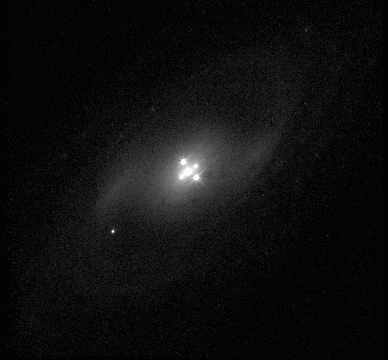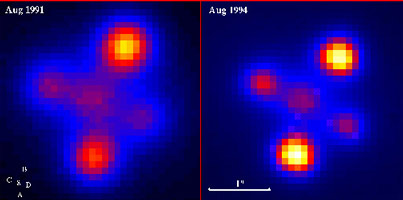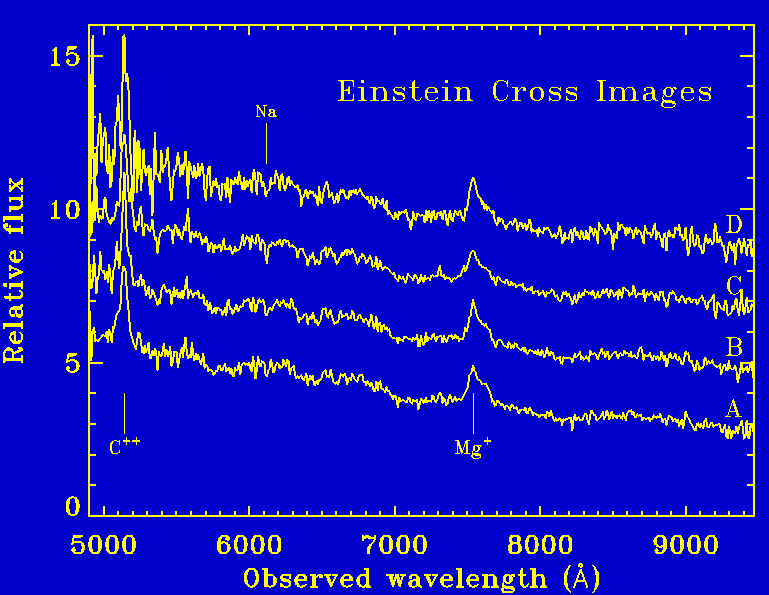Page 1 of 2
APOD: The Einstein Cross Gravitational Lens (2013 Jan 02)
Posted: Wed Jan 02, 2013 5:06 am
by APOD Robot
 The Einstein Cross Gravitational Lens
Explanation:
The Einstein Cross Gravitational Lens
Explanation: Most galaxies have a single nucleus -- does this galaxy have four? The strange answer leads
astronomers to conclude that the nucleus of the surrounding galaxy is not even visible in
this image. The central
cloverleaf is rather light emitted from a background
quasar. The
gravitational field of the visible foreground galaxy
breaks light from this distant
quasar into four distinct images. The
quasar must be properly aligned behind the center of a massive galaxy for a
mirage like this to be evident. The general effect is known as
gravitational lensing, and this specific case is known as the
Einstein Cross. Stranger still, the images of the
Einstein Cross vary in relative brightness, enhanced occasionally by the additional
gravitational microlensing effect of specific stars in the foreground galaxy.
[/b]
Re: APOD: The Einstein Cross Gravitational Lens (2013 Jan 02
Posted: Wed Jan 02, 2013 12:59 pm
by Tszabeau
What is the fifth object that's in the center of the four gravitationally lensed images?
Re: APOD: The Einstein Cross Gravitational Lens (2013 Jan 02
Posted: Wed Jan 02, 2013 1:52 pm
by BDanielMayfield
Tszabeau wrote:What is the fifth object that's in the center of the four gravitationally lensed images?
Since the explanation says that the center of the lensing galaxy isn't even visable I would guess that it is a microlense effect of some sort.
Re: APOD: The Einstein Cross Gravitational Lens (2013 Jan 02
Posted: Wed Jan 02, 2013 2:33 pm
by mwhidden
Why is the lensing galaxy not visible?
Re: APOD: The Einstein Cross Gravitational Lens (2013 Jan 02
Posted: Wed Jan 02, 2013 3:12 pm
by Chris Peterson
mwhidden wrote:Why is the lensing galaxy not visible?
It's not bright enough. Since the vast majority of mass in a galaxy is dark matter, even a dim galaxy can still be a strong gravitational lens.
Re: APOD: The Einstein Cross Gravitational Lens (2013 Jan 02
Posted: Wed Jan 02, 2013 3:19 pm
by NGC3314
That's a somewhat unfortunate phrasing - the core of the lensing galaxy is not completely obvious in this image, but it is visible. To see it more clearly,
here's a display of some archival Hubble data.

Re: APOD: The Einstein Cross Gravitational Lens (2013 Jan 02
Posted: Wed Jan 02, 2013 3:28 pm
by Chris Peterson
NGC3314 wrote:That's a somewhat unfortunate phrasing - the core of the lensing galaxy is not completely obvious in this image, but it is visible. To see it more clearly,
here's a display of some archival Hubble data.]
Good catch. It certainly does appear that all of the foreground galaxy is apparent in the higher quality HST image.
Re: APOD: The Einstein Cross Gravitational Lens (2013 Jan 02
Posted: Wed Jan 02, 2013 3:42 pm
by ritwik
many people argue that this is some other phenomenon, because the lensed quasar appear as four distinct dots as opposed to common "ring" feature
Re: APOD: The Einstein Cross Gravitational Lens (2013 Jan 02
Posted: Wed Jan 02, 2013 4:05 pm
by Chris Peterson
ritwik wrote:many people argue that this is some other phenomenon, because the lensed quasar appear as four distinct dots as opposed to common "ring" feature
I know of nobody who makes that argument. The mechanism by which gravitational lenses can produce multiple images (as opposed to arcs) is well understood, and this system has been gravitationally mapped, with the model producing the identical image in simulations. That this is an ordinary example of gravitational lensing seems beyond doubt.
Re: APOD: The Einstein Cross Gravitational Lens (2013 Jan 02
Posted: Wed Jan 02, 2013 4:18 pm
by FloridaMike
A few questions for your consideration:
With the quasar being so bright can we reasonably assume the intermediate galaxy is in the quasar "beam"?
Do we know the distance between the quasar and the intermediate galaxy?
Is it possible the intermediate galaxy is receiving dangerous levels of radiation from the quasar?
If the intermediate galaxy was not there would there be any measurable effect of the quasar here?
Re: APOD: The Einstein Cross Gravitational Lens (2013 Jan 02
Posted: Wed Jan 02, 2013 4:50 pm
by bbhar
This APOD is same as APOD of 2010 February 7.
Re: APOD: The Einstein Cross Gravitational Lens (2013 Jan 02
Posted: Wed Jan 02, 2013 4:57 pm
by fastartcee
Chris Peterson wrote:ritwik wrote:many people argue that this is some other phenomenon, because the lensed quasar appear as four distinct dots as opposed to common "ring" feature
I know of nobody who makes that argument. The mechanism by which gravitational lenses can produce multiple images (as opposed to arcs) is well understood, and this system has been gravitationally mapped, with the model producing the identical image in simulations. That this is an ordinary example of gravitational lensing seems beyond doubt.
I do not understand, if the background object is well-aligned, why the lensing phenomenon would not produce a ring as opposed to four distinct dots.
Not being an astro-physicist, I'm not looking for a detailed mathematical explanation, but, rather, I'd like to be able to gain a conceptual grasp of the four-dot phenomenon. Like, why four dots? Why not six, or eight? If the foreground object
was a lens, we certainly would not see the background object as four distinct dots.
Thanks in advance for any explanation.
Re: APOD: The Einstein Cross Gravitational Lens (2013 Jan 02
Posted: Wed Jan 02, 2013 5:02 pm
by Chris Peterson
FloridaMike wrote:With the quasar being so bright can we reasonably assume the intermediate galaxy is in the quasar "beam"?
That's a reasonable assumption, but it does depend on the uncertain (but likely) possibility that the brightness of a quasar is related to being in line with its jets. There are models that assume quasars radiate isotropically.
Do we know the distance between the quasar and the intermediate galaxy?
The quasar is around 8 billion light years away, compared with less than a half billion for the intervening galaxy.
Is it possible the intermediate galaxy is receiving dangerous levels of radiation from the quasar?
Not even close.
If the intermediate galaxy was not there would there be any measurable effect of the quasar here?
No, all that would change is that we'd image it as a single dot instead of four. For all practical purposes, the quasar can be treated as being the same distance both from us and from the lensing galaxy.
Re: APOD: The Einstein Cross Gravitational Lens (2013 Jan 02
Posted: Wed Jan 02, 2013 5:13 pm
by bbhar
And also same as APOD of 2007 March 11.
Re: APOD: The Einstein Cross Gravitational Lens (2013 Jan 02
Posted: Wed Jan 02, 2013 5:13 pm
by Chris Peterson
fastartcee wrote:I do not understand, if the background object is well-aligned, why the lensing phenomenon would not produce a ring as opposed to four distinct dots.
Not being an astro-physicist, I'm not looking for a detailed mathematical explanation, but, rather, I'd like to be able to gain a conceptual grasp of the four-dot phenomenon. Like, why four dots? Why not six, or eight?
It could be a different number. Discrete images are explained by a part of GR that describes gravity in terms of quadrupole moments (search on 'quadrupole gravitational lens') and on asymmetrical mass structures- for example, elliptical galaxies with tidal tail structures, or certain spiral structures. The asymmetry can be present in either of the two galaxies, or in both.
If the foreground object was a lens, we certainly would not see the background object as four distinct dots.
If the foreground object was an ordinary lens, we'd not see arcs, either. Gravitational lenses behave very differently from ordinary glass lenses; the former creates the maximum refraction along the optical axis, with the effect diminishing as you move outwards. The latter creates the maximum refraction at its outside edges, with little effect towards the center. Gravitational lenses can't produce true images at all.
Re: APOD: The Einstein Cross Gravitational Lens (2013 Jan 02
Posted: Wed Jan 02, 2013 5:15 pm
by ritwik
fastartcee wrote:Chris Peterson wrote:ritwik wrote:many people argue that this is some other phenomenon, because the lensed quasar appear as four distinct dots as opposed to common "ring" feature
I know of nobody who makes that argument. The mechanism by which gravitational lenses can produce multiple images (as opposed to arcs) is well understood, and this system has been gravitationally mapped, with the model producing the identical image in simulations. That this is an ordinary example of gravitational lensing seems beyond doubt.
I do not understand, if the background object is well-aligned, why the lensing phenomenon would not produce a ring as opposed to four distinct dots.
Not being an astro-physicist, I'm not looking for a detailed mathematical explanation, but, rather, I'd like to be able to gain a conceptual grasp of the four-dot phenomenon. Like, why four dots? Why not six, or eight? If the foreground object
was a lens, we certainly would not see the background object as four distinct dots.
Thanks in advance for any explanation.
the mainstrem explanation is that it is because of "uneven mass distribution" in the intermediary galaxy
 http://milesmathis.com/lens.html
http://milesmathis.com/lens.html
on this ↑ site author points out that those 4 dots are pretty crisp and round-ish
they fail to explain why the light between those 4 dots condensed in to single points instead of forming a bleary arc

Re: APOD: The Einstein Cross Gravitational Lens (2013 Jan 02
Posted: Wed Jan 02, 2013 5:22 pm
by rguyg
I was wondering how long is this going to be visible? from our point of view.
Re: APOD: The Einstein Cross Gravitational Lens (2013 Jan 02
Posted: Wed Jan 02, 2013 5:27 pm
by NGC3314
The classical Einstein ring is an idealization, in the case of an extended object located exactly behind a lensing mass which is circularly symmetric about an axis matching our line of sight. For a circular lens, increasing misalignment will first make the ring uneven (brightest at two opposite areas), then break the ring into two arcs. For a noncircular lens (such as a disk galaxy, or a galaxy group or cluster), this ring gets broken into more than two segments, appearing wherever the bending angle from the actual mass distribution is right for the rays to reach us. And when the lensed object is a quasar, it is so compact that even Hubble images don't show the nucleus being stretched into an arc - it remains below the resolution limit of the telescope. Such techniques as IR imaging, where the host galaxy around lensed quasars is easer to see, have revealed the arcs from lensed galaxies around the quasars - see the
CASTLES project pages, for example,
In the case of 2237+030, additional data supporting a lens interpretation include having spectra which are identical except for differing amounts of absorption from interstellar gas at the galaxy's redshift (I know of sodium absorption lines) and monitoring showing the four images to have matching variability patterns with time delays among them that make sense for the lensing paths through the galaxy's gravitational well. For example, here are some oldish spectra of the four quasar images from data taken in very good seeing with the 4.2m WHT at La Palma (
source).
(How odd - Google just showed me that someone has, umm, mirrored that entire site in Bulgaria).
Re: APOD: The Einstein Cross Gravitational Lens (2013 Jan 02
Posted: Wed Jan 02, 2013 5:34 pm
by bystander
bbhar wrote:This APOD is same as APOD of 2010 February 7.
bbhar wrote:And also same as APOD of 2007 March 11.
And 2005 March 27, and 2000 October 10. Your point is

Re: APOD: The Einstein Cross Gravitational Lens (2013 Jan 02
Posted: Wed Jan 02, 2013 5:57 pm
by Chris Peterson
ritwik wrote:the mainstrem explanation is that it is because of "uneven mass distribution" in the intermediary galaxy.
The definition of "mainstream" is such that if you have a problem with it, the burden is largely on you to demonstrate its deficiencies, not on the mainstream to defend its position. In fact, the mainstream position is a solid one, supported by many refereed papers (look up 'quadrupole gravitational lens').
The above website is operated by a crank, and is chock-full of pseudoscience. It does not bear discussion, and indeed, any real discussion of this kook's ideas is likely to violate the rules of this forum.
Re: APOD: The Einstein Cross Gravitational Lens (2013 Jan 02
Posted: Wed Jan 02, 2013 6:16 pm
by hwelborn
So cool. A good lesson here, too, about illusions.
Re: APOD: The Einstein Cross Gravitational Lens (2013 Jan 02
Posted: Wed Jan 02, 2013 7:40 pm
by Anthony Barreiro
Chris Peterson wrote:...If the foreground object was an ordinary lens, we'd not see arcs, either. Gravitational lenses behave very differently from ordinary glass lenses; the former creates the maximum refraction along the optical axis, with the effect diminishing as you move outwards. The latter creates the maximum refraction at its outside edges, with little effect towards the center. Gravitational lenses can't produce true images at all.
Aha. My first apod revelation of the new calendar year. Thanks Chris!
Re: APOD: The Einstein Cross Gravitational Lens (2013 Jan 02
Posted: Wed Jan 02, 2013 8:50 pm
by Boomer12k
Interesting phenomena. Gravitational Lensing does not always form an Arc, probably because it is not Lensing another, closer galaxy, so you get the lensing of a point. Like lensing a Star, so to speak.
Here is another example of a weird lensing of a Quasar. (Bottom).
And here is another "Einstein Cross". Humor never hurts too much.
:---[===] *
Re: APOD: The Einstein Cross Gravitational Lens (2013 Jan 02
Posted: Wed Jan 02, 2013 9:04 pm
by bystander
Re: APOD: The Einstein Cross Gravitational Lens (2013 Jan 02
Posted: Wed Jan 02, 2013 10:49 pm
by quigley
Since this image is rather "old" as has been pointed out, are there any more recent, more detailed, that may be posted instead for the next go-around of the Einstein Cross Gravitational Lens? Maybe some false-color image that more clearly illustrates the structures of the quasar and the galaxy?
 The Einstein Cross Gravitational Lens
The Einstein Cross Gravitational Lens

